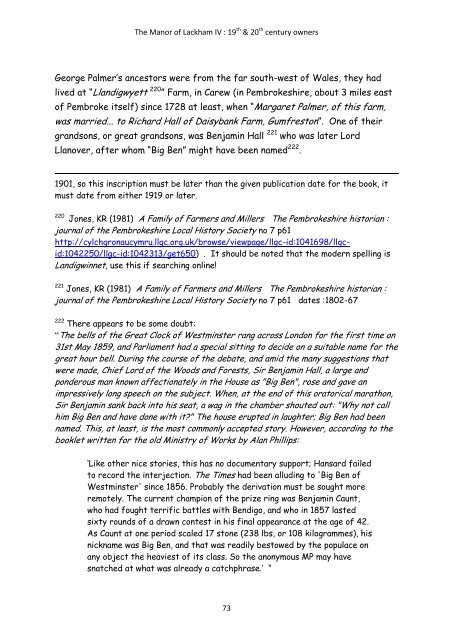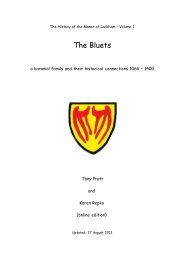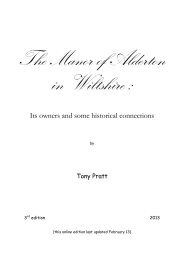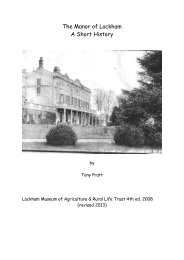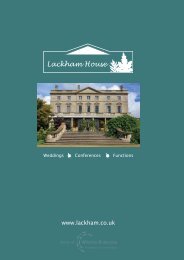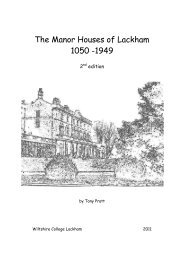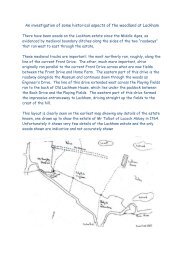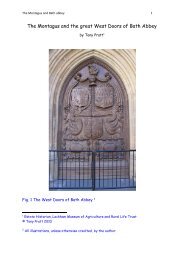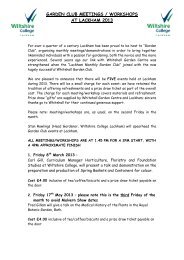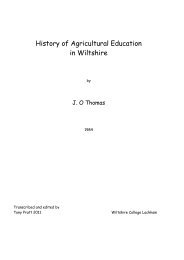The owners of Lackham in the Nineteenth and Twentieth centuries ...
The owners of Lackham in the Nineteenth and Twentieth centuries ...
The owners of Lackham in the Nineteenth and Twentieth centuries ...
Create successful ePaper yourself
Turn your PDF publications into a flip-book with our unique Google optimized e-Paper software.
<strong>The</strong> Manor <strong>of</strong> <strong>Lackham</strong> IV : 19 th & 20 th century <strong>owners</strong><br />
George Palmer’s ancestors were from <strong>the</strong> far south-west <strong>of</strong> Wales, <strong>the</strong>y had<br />
lived at “Ll<strong>and</strong>igwyett 220 ” Farm, <strong>in</strong> Carew (<strong>in</strong> Pembrokeshire, about 3 miles east<br />
<strong>of</strong> Pembroke itself) s<strong>in</strong>ce 1728 at least, when “Margaret Palmer, <strong>of</strong> this farm,<br />
was married... to Richard Hall <strong>of</strong> Daisybank Farm, Gumfreston”. One <strong>of</strong> <strong>the</strong>ir<br />
gr<strong>and</strong>sons, or great gr<strong>and</strong>sons, was Benjam<strong>in</strong> Hall 221 who was later Lord<br />
Llanover, after whom “Big Ben” might have been named 222 .<br />
1901, so this <strong>in</strong>scription must be later than <strong>the</strong> given publication date for <strong>the</strong> book, it<br />
must date from ei<strong>the</strong>r 1919 or later.<br />
220<br />
Jones, KR (1981) A Family <strong>of</strong> Farmers <strong>and</strong> Millers <strong>The</strong> Pembrokeshire historian :<br />
journal <strong>of</strong> <strong>the</strong> Pembrokeshire Local History Society no 7 p61<br />
http://cylchgronaucymru.llgc.org.uk/browse/viewpage/llgc-id:1041698/llgcid:1042250/llgc-id:1042313/get650)<br />
. It should be noted that <strong>the</strong> modern spell<strong>in</strong>g is<br />
L<strong>and</strong>igw<strong>in</strong>net, use this if search<strong>in</strong>g onl<strong>in</strong>e!<br />
221 Jones, KR (1981) A Family <strong>of</strong> Farmers <strong>and</strong> Millers <strong>The</strong> Pembrokeshire historian :<br />
journal <strong>of</strong> <strong>the</strong> Pembrokeshire Local History Society no 7 p61 dates :1802-67<br />
222 <strong>The</strong>re appears to be some doubt:<br />
“<strong>The</strong> bells <strong>of</strong> <strong>the</strong> Great Clock <strong>of</strong> Westm<strong>in</strong>ster rang across London for <strong>the</strong> first time on<br />
31st May 1859, <strong>and</strong> Parliament had a special sitt<strong>in</strong>g to decide on a suitable name for <strong>the</strong><br />
great hour bell. Dur<strong>in</strong>g <strong>the</strong> course <strong>of</strong> <strong>the</strong> debate, <strong>and</strong> amid <strong>the</strong> many suggestions that<br />
were made, Chief Lord <strong>of</strong> <strong>the</strong> Woods <strong>and</strong> Forests, Sir Benjam<strong>in</strong> Hall, a large <strong>and</strong><br />
ponderous man known affectionately <strong>in</strong> <strong>the</strong> House as "Big Ben", rose <strong>and</strong> gave an<br />
impressively long speech on <strong>the</strong> subject. When, at <strong>the</strong> end <strong>of</strong> this oratorical marathon,<br />
Sir Benjam<strong>in</strong> sank back <strong>in</strong>to his seat, a wag <strong>in</strong> <strong>the</strong> chamber shouted out: "Why not call<br />
him Big Ben <strong>and</strong> have done with it?" <strong>The</strong> house erupted <strong>in</strong> laughter; Big Ben had been<br />
named. This, at least, is <strong>the</strong> most commonly accepted story. However, accord<strong>in</strong>g to <strong>the</strong><br />
booklet written for <strong>the</strong> old M<strong>in</strong>istry <strong>of</strong> Works by Alan Phillips:<br />
‘Like o<strong>the</strong>r nice stories, this has no documentary support; Hansard failed<br />
to record <strong>the</strong> <strong>in</strong>terjection. <strong>The</strong> Times had been allud<strong>in</strong>g to 'Big Ben <strong>of</strong><br />
Westm<strong>in</strong>ster' s<strong>in</strong>ce 1856. Probably <strong>the</strong> derivation must be sought more<br />
remotely. <strong>The</strong> current champion <strong>of</strong> <strong>the</strong> prize r<strong>in</strong>g was Benjam<strong>in</strong> Caunt,<br />
who had fought terrific battles with Bendigo, <strong>and</strong> who <strong>in</strong> 1857 lasted<br />
sixty rounds <strong>of</strong> a drawn contest <strong>in</strong> his f<strong>in</strong>al appearance at <strong>the</strong> age <strong>of</strong> 42.<br />
As Caunt at one period scaled 17 stone (238 lbs, or 108 kilogrammes), his<br />
nickname was Big Ben, <strong>and</strong> that was readily bestowed by <strong>the</strong> populace on<br />
any object <strong>the</strong> heaviest <strong>of</strong> its class. So <strong>the</strong> anonymous MP may have<br />
snatched at what was already a catchphrase.’ “<br />
73


